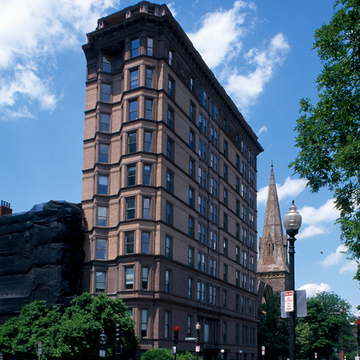This skinny tall apartment block, built by real estate developer W. H. H. Newman in tan brick with brownstone, stimulated Boston's first serious height controls. Haddon Hall's nine stories threatened to make older houses obsolete and challenged Back Bay's low-scale cityscape. Some citizens, under the auspices of the Twentieth Century Club, mobilized a height-restriction campaign to prevent more such “monstrosities.” The Boston Park Commissioners, who already limited building heights to seventy feet along parkways, received legislative authority in 1896 to extend their policy to Commonwealth Avenue. Whereas this control used eminent domain to limit building heights, economics helped doom larger apartment blocks in the Back Bay. Opening in the midst of a depression, Haddon Hall paid no dividends. Thus, those seeking to build similar tall buildings had no basis to claim potential loss of profits. By such means was the area's domestic scale preserved until police power zoning became the norm.
You are here
Haddon Hall
If SAH Archipedia has been useful to you, please consider supporting it.
SAH Archipedia tells the story of the United States through its buildings, landscapes, and cities. This freely available resource empowers the public with authoritative knowledge that deepens their understanding and appreciation of the built environment. But the Society of Architectural Historians, which created SAH Archipedia with University of Virginia Press, needs your support to maintain the high-caliber research, writing, photography, cartography, editing, design, and programming that make SAH Archipedia a trusted online resource available to all who value the history of place, heritage tourism, and learning.




















